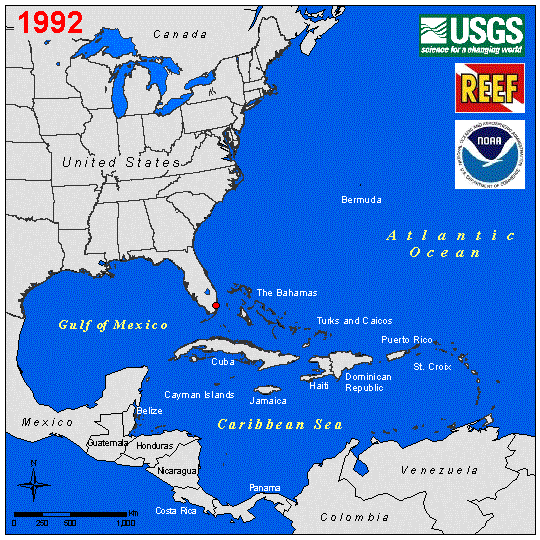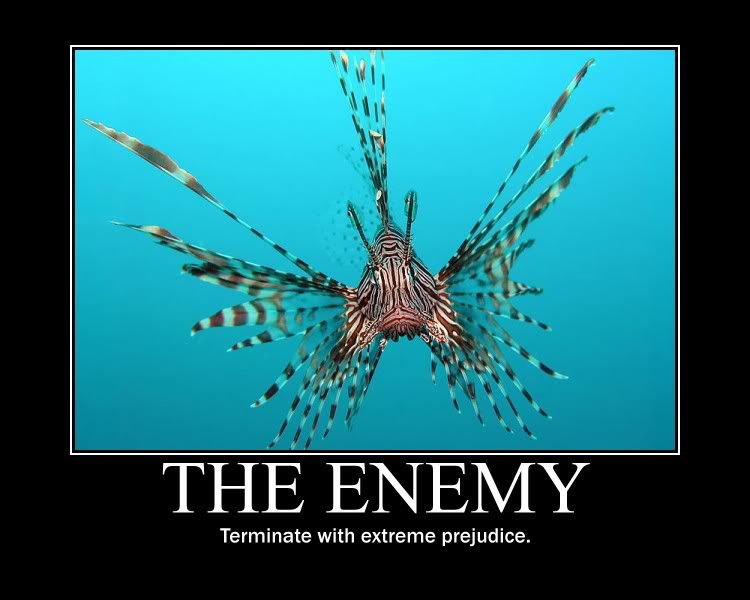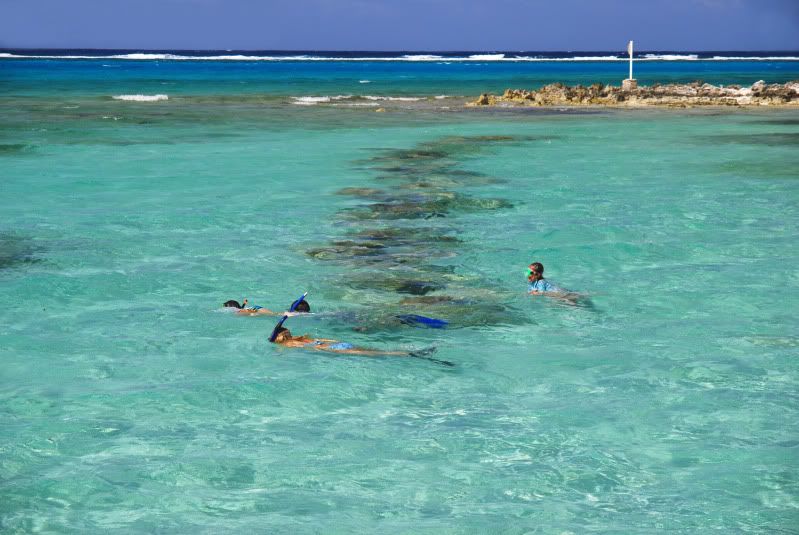Roombaguy
Contributor
See full article below.
Also, there is a fairly active Facebook group called "DOE Lionfish Culling Group" with lots of information, pictures & videos.
-------------------------------------
The Department of Environment is taking lionfish awareness on the road, with awareness evenings planned throughout Grand Cayman.
There will be a presentation every Saturday evening at 6.30pm up to the end of June, with the department urging anyone who swims, dives, snorkels, fishes or just has an interest in the well-being of Caymans reefs to attend the sessions.
The talks are meant to give the public easier access to information on lionfish in Cayman. The information covered will include; how lionfish got here; why they are so dangerous; what research has been done on them and what DoE is doing about it, said Bradley Johnson, a research officer with the Department of Environment.
According to Mr. Johnson, the talks will be about an hour long and he plans to have a live lionfish at the meetings to show people what to look out for.
They make it much easier to relate to seeing them alive instead of in a photo or video, he said.
The lionfish is an invasive species that poses a great threat to local species. It is a voracious predator, feeding on anything it can swallow and reaches maturity much more quickly than competing species. The fish also has venomous dorsal spines that can deliver a very painful sting if the fish is handled.
According to Mr. Johnson, lionfish are still being found all over Cayman and numbers are not decreasing in spite of vigorous control measures.
Between DoE and our licensed cullers weve removed over 1,500 fish since January 2009 from all three Islands. We have over 350 people now licensed to remove lionfish for us and Im hoping to increase that number through these talks. The more people we have aware and licensed the more effective our control programme will be, he said.
According to Mr. Johnson, the department does not expect these measures to eradicate lionfish from Caymans waters.
The goal of our control programme is to remove as many lionfish as possible. This will serve two purposes: first, the more lionfish we remove the fewer of our local species of fish will be eaten by them; and second, this will give more time for fish to adapt to their presence and learn to eat them or avoid them, he said.
The meetings will take place on 15 May at the East End Civic Centre, 22 May at Savannah Primary School, 29 May at Elmslie Memorial Church Hall in George Town, 5 June at Bodden Town Primary School, 19 June at South Sound Community Centre and 26 June at John A. Cumber School in West Bay.
For more information on the programme, contact 949-8469.
Corn-dusted lionfish BLT wrap
4 lionfish fillets, 6-8ounces each, split lengthwise
3 eggs, lightly beaten with a ½ cup whole milk
Corndust
8 apple-smoked bacon slices, cooked crispy, fat reserved
½ cupvegetable oil
2 ripe plum tomatoes, split lengthwise and sliced ¼in thick
1 red onion, julienned
1 head of romaine, cleaned, dried and roughly chopped
4 10-inch flour tortilla wraps, or any wrap of your choice
1lb baby spinach, trimmed, washed and dried
In a sauté pan, heat the vegetable oil and bacon fat over moderate heat. Dry the fillets with paper towels, dip them in the egg/milk mixture and then coat with the corn dust. Sauté until golden brown, set aside on paper towels.
To make the wraps, warm the tortillas on a grill, over an open flame or in the microwave. On the lower third of the tortilla, spread the chipotle mayonnaise, (as much as you desire), place two fillets on the mayonnaise, top with two slices of bacon, the tomatoes, lettuce and wrap tightly.
In a bowl, lightly toss the spinach with the vinaigrette, season to taste with salt and black pepper.
To plate, place the spinach salad in the centre of the plate, cut each wrap on a bias and lean the two pieces on the salad. Enjoy!
Sherry honey lime vinaigrette
4ozsherry vinegar
Juice of 3 limes
Zest of 1 lime
2ozhoney
2ozcanola oil
1tspbroasted shallots, minced
To taste, salt &fresh ground black pepper
Chipotle Mayonnaise
3 ozfresh lime juice
7ounce canchipotle chillies in adobo
1 quartmayonnaise
2 ½ tspkosher salt
1tspfresh ground black pepper
To make the chipotle mayonnaise, blend the lime juice and chipotles in a blender. In a bowl, whisk the chipotle puree into remaining ingredients, chill for at least one day so that the flavours can develop.
Corn Dust
1cup cornmeal
1 tspcumin
½ tspchili powder
1 tspkosher salt
cayCompass.com :: Lionfish awareness goes to districts
Also, there is a fairly active Facebook group called "DOE Lionfish Culling Group" with lots of information, pictures & videos.
-------------------------------------
The Department of Environment is taking lionfish awareness on the road, with awareness evenings planned throughout Grand Cayman.
There will be a presentation every Saturday evening at 6.30pm up to the end of June, with the department urging anyone who swims, dives, snorkels, fishes or just has an interest in the well-being of Caymans reefs to attend the sessions.
The talks are meant to give the public easier access to information on lionfish in Cayman. The information covered will include; how lionfish got here; why they are so dangerous; what research has been done on them and what DoE is doing about it, said Bradley Johnson, a research officer with the Department of Environment.
According to Mr. Johnson, the talks will be about an hour long and he plans to have a live lionfish at the meetings to show people what to look out for.
They make it much easier to relate to seeing them alive instead of in a photo or video, he said.
The lionfish is an invasive species that poses a great threat to local species. It is a voracious predator, feeding on anything it can swallow and reaches maturity much more quickly than competing species. The fish also has venomous dorsal spines that can deliver a very painful sting if the fish is handled.
According to Mr. Johnson, lionfish are still being found all over Cayman and numbers are not decreasing in spite of vigorous control measures.
Between DoE and our licensed cullers weve removed over 1,500 fish since January 2009 from all three Islands. We have over 350 people now licensed to remove lionfish for us and Im hoping to increase that number through these talks. The more people we have aware and licensed the more effective our control programme will be, he said.
According to Mr. Johnson, the department does not expect these measures to eradicate lionfish from Caymans waters.
The goal of our control programme is to remove as many lionfish as possible. This will serve two purposes: first, the more lionfish we remove the fewer of our local species of fish will be eaten by them; and second, this will give more time for fish to adapt to their presence and learn to eat them or avoid them, he said.
The meetings will take place on 15 May at the East End Civic Centre, 22 May at Savannah Primary School, 29 May at Elmslie Memorial Church Hall in George Town, 5 June at Bodden Town Primary School, 19 June at South Sound Community Centre and 26 June at John A. Cumber School in West Bay.
For more information on the programme, contact 949-8469.
Corn-dusted lionfish BLT wrap
4 lionfish fillets, 6-8ounces each, split lengthwise
3 eggs, lightly beaten with a ½ cup whole milk
Corndust
8 apple-smoked bacon slices, cooked crispy, fat reserved
½ cupvegetable oil
2 ripe plum tomatoes, split lengthwise and sliced ¼in thick
1 red onion, julienned
1 head of romaine, cleaned, dried and roughly chopped
4 10-inch flour tortilla wraps, or any wrap of your choice
1lb baby spinach, trimmed, washed and dried
In a sauté pan, heat the vegetable oil and bacon fat over moderate heat. Dry the fillets with paper towels, dip them in the egg/milk mixture and then coat with the corn dust. Sauté until golden brown, set aside on paper towels.
To make the wraps, warm the tortillas on a grill, over an open flame or in the microwave. On the lower third of the tortilla, spread the chipotle mayonnaise, (as much as you desire), place two fillets on the mayonnaise, top with two slices of bacon, the tomatoes, lettuce and wrap tightly.
In a bowl, lightly toss the spinach with the vinaigrette, season to taste with salt and black pepper.
To plate, place the spinach salad in the centre of the plate, cut each wrap on a bias and lean the two pieces on the salad. Enjoy!
Sherry honey lime vinaigrette
4ozsherry vinegar
Juice of 3 limes
Zest of 1 lime
2ozhoney
2ozcanola oil
1tspbroasted shallots, minced
To taste, salt &fresh ground black pepper
Chipotle Mayonnaise
3 ozfresh lime juice
7ounce canchipotle chillies in adobo
1 quartmayonnaise
2 ½ tspkosher salt
1tspfresh ground black pepper
To make the chipotle mayonnaise, blend the lime juice and chipotles in a blender. In a bowl, whisk the chipotle puree into remaining ingredients, chill for at least one day so that the flavours can develop.
Corn Dust
1cup cornmeal
1 tspcumin
½ tspchili powder
1 tspkosher salt
cayCompass.com :: Lionfish awareness goes to districts








 's
's
